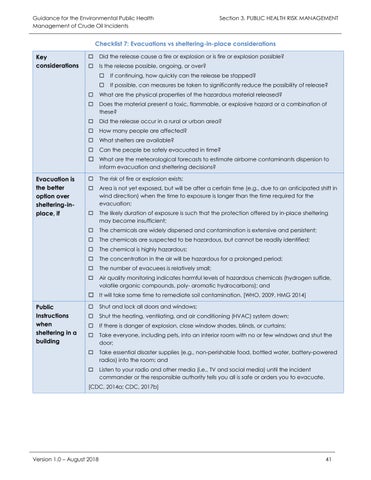Guidance for the Environmental Public Health Management of Crude Oil Incidents
Section 3. PUBLIC HEALTH RISK MANAGEMENT
Checklist 7: Evacuations vs sheltering-in-place considerations Key considerations
Did the release cause a fire or explosion or is fire or explosion possible?
Is the release possible, ongoing, or over?
If continuing, how quickly can the release be stopped?
If possible, can measures be taken to significantly reduce the possibility of release?
What are the physical properties of the hazardous material released?
Does the material present a toxic, flammable, or explosive hazard or a combination of these?
Did the release occur in a rural or urban area?
How many people are affected?
What shelters are available?
Can the people be safely evacuated in time?
What are the meteorological forecasts to estimate airborne contaminants dispersion to inform evacuation and sheltering decisions?
Evacuation is the better option over sheltering-inplace, if
The risk of fire or explosion exists;
Area is not yet exposed, but will be after a certain time (e.g., due to an anticipated shift in wind direction) when the time to exposure is longer than the time required for the evacuation;
The likely duration of exposure is such that the protection offered by in-place sheltering may become insufficient;
The chemicals are widely dispersed and contamination is extensive and persistent;
The chemicals are suspected to be hazardous, but cannot be readily identified;
The chemical is highly hazardous;
The concentration in the air will be hazardous for a prolonged period;
The number of evacuees is relatively small;
Air quality monitoring indicates harmful levels of hazardous chemicals (hydrogen sulfide, volatile organic compounds, poly- aromatic hydrocarbons); and
It will take some time to remediate soil contamination. [WHO, 2009, HMG 2014] Public Instructions when sheltering in a building
Shut and lock all doors and windows;
Shut the heating, ventilating, and air conditioning (HVAC) system down;
If there is danger of explosion, close window shades, blinds, or curtains;
Take everyone, including pets, into an interior room with no or few windows and shut the door;
Take essential disaster supplies (e.g., non-perishable food, bottled water, battery-powered radios) into the room; and
Listen to your radio and other media (i.e., TV and social media) until the incident commander or the responsible authority tells you all is safe or orders you to evacuate.
[CDC, 2014a; CDC, 2017b]
Version 1.0 – August 2018
41







